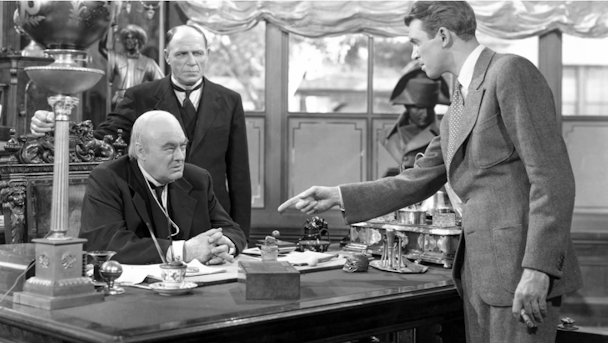In brutal world of finance, how can building societies win customers?
As part of our Finance & Utilities Focus, we ask, in the age of ‘nowhereness,’ where the concept of community can mean little, what brand messages building societies are relying on to win over savers and borrowers.

Community spirit saved George Bailey, but can brand messaging around community promise a bright future for building societies?
Since the 18th century, UK building societies have been roundly recognized as pillars of trust and community in what is an often untrusted financial landscape. Standing apart from the major high street banking brands, building societies have long offered a friendlier, more personal service deeply rooted in local community and mutuality.
But as younger consumers demand increasingly digital experiences that aren’t always rooted in location, real-world geographies or face-to-face interactions, the question of how the humble building society markets its products and services is becoming increasingly complex. Most Brits of a certain generation are familiar with their local building society – as a boy, mine was the Derbyshire – and they understand how societies differ from the big bank that once dominated the high street but are now slugging it out in the digital realm.
The UK’s biggest and best-known building society, Nationwide, has recently been battling to bridge the gap between tradition and modernity with its ‘A Good Way to Bank’ campaign, fronted by actor Dominic West and created by agency New Commercial Arts. When not getting into trouble with ASA, the ad campaign, the brand’s biggest in 36 years, has set out to solidify its commitment to face-to-face banking, even as many banks close their branches. By emphasizing its member-centric ethos, Nationwide is aiming to differentiate itself from its competitors and remain relevant to younger consumers. But not all building societies have the national scale or marketing pounds of Nationwide, which ultimately means marketing smarter rather than harder to meet the ongoing challenge of engaging potential customers.
Rather than attempting to outshout its banking competitors, Newcastle Building Society, which has 31 branches across the North East, Cumbria and Yorkshire and is the UK’s eighth largest mutual, is taking a different approach. “The Newcastle Building Society approaches things differently because we are much more interested in depth rather than reach,” says Andrew Nicholson, its head of brand and member engagement. “This means we value deep relationships with fewer people rather than shallow relationships with many. As a result, we think less about cut through and interruption than about community and connection. We are much more focused on helping our members build their stories and their future than in broadcasting our own.”
This emphasis on depth rather than noise allows Newcastle to focus on community-driven stories, building meaningful connections with their members instead of merely vying for attention.
Want to go deeper? Ask The Drum
170 miles south, Phillip Ward, brand lead at Nottingham Building Society, which spans nine midlands counties with its 31-branch network, shares a similar stance in his quest to recruit new customers: “Generally, the major banks are trying to attract a massive proportion of the UK market with their communications. As an ambitious regional building society, our approach is to develop much more targeted marketing aimed at talking to smaller audiences with more nuanced needs. This provides us with the opportunity to talk about our brand and how it can solve a problem in a much more relevant way.”
By understanding these unique nuanced needs of their communities, building societies such as Nottingham is able to deliver more relevant messages that resonate on a deeper level.
For decades, building societies have been perceived as the friendlier face of banking and bastions of stability and legacy. While these fine qualities can be appealing, especially during times of financial uncertainty (which the UK is no stranger to), they can also be seen as a barrier when trying to attract younger, tech-savvy customers who value convenience and innovation. Both Nicholson and Ward are keenly aware of this dichotomy and offer distinct perspectives on how to bridge the gap.
“We are an intergenerational brand, with some branches having members from three generations and of all ages,” says Nicholson. “The choice for us isn’t between ‘legacy’ and ‘technology’ or ‘trust’ and ‘innovation.’ Our experience is that younger audiences crave the physical, the analog, and the real just as much as the digital, frictionless and mobile. Our task is to serve our members, whatever the context, their service preference or their age.”
Nicholson believes that building societies don’t necessarily need to abandon their roots to appeal to younger generations and can instead celebrate their physical presence while providing a digital experience that caters to modern expectations.
Ward, meanwhile, believes that appealing to younger audiences is less about projecting an image of innovation and more about demonstrating a genuine understanding of their needs. “We recognize that we have a unique place in our local communities,” he explains. “But the world is changing, and we need to innovate to stay meaningful and relevant.”
For Ward, it’s not about innovation for innovation’s sake but ensuring that younger consumers see building societies as institutions that can meet their evolving expectations, whether it’s through improved digital platforms, tools or superior personal services.
Mutuality has always been a cornerstone of British building societies; we’re all in this together supporting each other – akin to George Bailey running through the snow-filled streets of Bedford Falls shouting how much he loves his ‘Building and Loan.’ But is mutuality as important to the next generation of consumers?
Nicholson says: “The whole category has done a poor job of explaining mutuality in terms people understand and connect with. But mutuality is the original and authentic form of brand purpose, formulated 200 years before this even became a marketing buzzword.
“At Newcastle Building Society, purpose drives everything we do. This focus on mutuality as an authentic brand purpose could be key to appealing to younger audiences, many of whom are increasingly drawn to brands that align with their values.”
Ward agrees, noting that the social impact, ethics and values inherent in the building society model are particularly resonant with younger audiences: “Our insight suggests that social impact is as important to younger audiences as any other group,” says Ward. “Acting with integrity, ethics and values and making a positive difference to the lives of people matters to this group. In a crowded marketplace where there’s little else to differentiate providers, this activity should be a strong brand benefit. Building societies can react and respond to what their customers want from their community investment by keeping a constant dialogue with them, with the distribution of the community support reflecting the audience they are talking to, ensuring relevance irrespective of location.”
In an age where location can feel meaningless in the face of digital convenience, this kind of meaningful engagement can set building societies apart from their larger, more impersonal competitors.
Advertisement
Convenience v connection
The question of convenience looms large for building societies. While many consumers appreciate the ease of digital banking and 24/7 service, building societies are often associated with a more localized, traditional (altogether more personal) service model. Nicholson and Ward both see convenience as a key area where societies must adapt without losing sight of their core values.
“Branches and locations, digitalization and 24-hour convenience are part of an integrated strategy of meeting members where they are and serving their needs in the way that suits them best,” Nicholson says. This integrated strategy is crucial in balancing the personal, face-to-face service that many building society members value with the convenience that younger consumers expect.
Meanwhile, Ward in Nottingham believes that the definition of convenience may need to be reconsidered within the context of building societies, saying: “Convenience in the building society sector may simply mean having a branch that’s open six days a week or being able to contact a local call center that you can get through to quickly.” He adds: “Assuming we’re meeting or exceeding customer expectations, we can focus on what we do better than our competitors.” This suggests that building societies don’t necessarily need to replicate the services of major banks but should instead focus on their strengths – such as local service and personalized support – while ensuring they meet basic convenience standards.
Advertisement
Community goes social
Both Nicholson and Ward acknowledge the untapped potential of social media as a tool for engaging younger consumers. “Social has a tremendous opportunity to build community and connect hyper-locally,” Nicholson says, emphasizing the power of social platforms to create a sense of local belonging even in a digital space. Ward adds: “Social media plays an essential role in building society marketing, especially when targeting younger consumers, by acting as a platform for engagement, storytelling, and community building.”
This recognition of social media as a key tool for engagement signals an important shift in how building societies approach their marketing strategies. By leveraging social media effectively, building societies can create more targeted, authentic connections with younger audiences using the platforms that these consumers are already spending their time on.
Suggested newsletters for you
The marketing challenges faced by building societies are complex, but they also present unique opportunities. By emphasizing depth overreach, balancing tradition with innovation and leveraging their inherent values of mutuality and community, building societies definitely have the potential to carve out a distinctive position in the modern financial landscape and one that resonates deeply with younger consumers seeking both convenience and meaningful engagement
As Nicholson concludes: “The nowhereness of digital banking is a great gift to us, throwing our difference into sharper relief.” It is this difference - this commitment to community, purpose, and local engagement - that may well be the key to building societies’ marketing and brand success in the years ahead.
